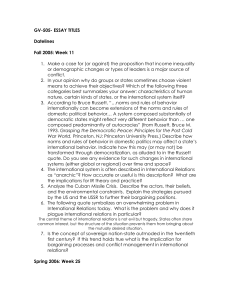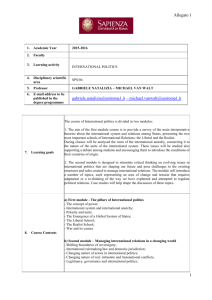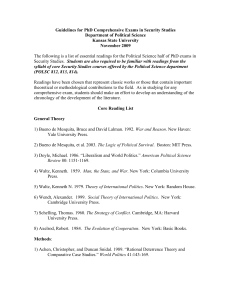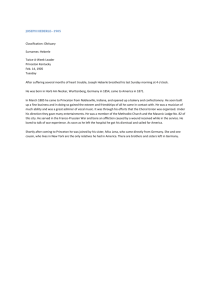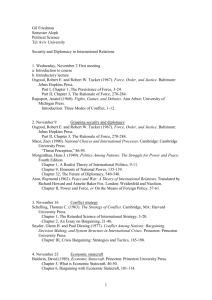International Relations Theory
advertisement
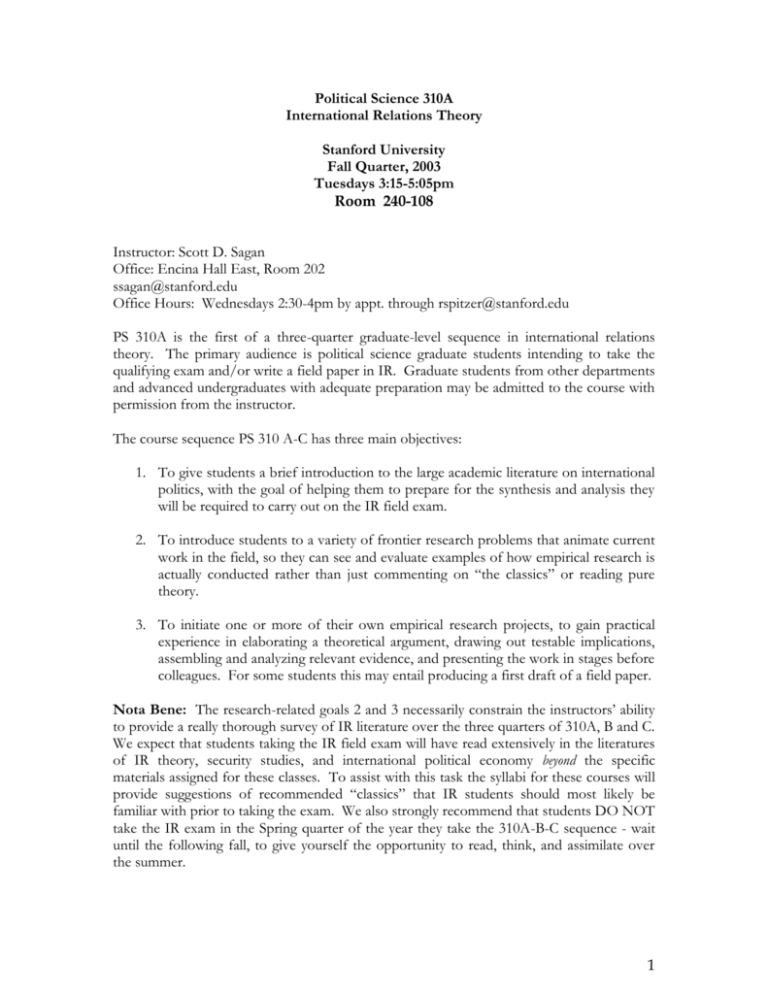
Political Science 310A International Relations Theory Stanford University Fall Quarter, 2003 Tuesdays 3:15-5:05pm Room 240-108 Instructor: Scott D. Sagan Office: Encina Hall East, Room 202 ssagan@stanford.edu Office Hours: Wednesdays 2:30-4pm by appt. through rspitzer@stanford.edu PS 310A is the first of a three-quarter graduate-level sequence in international relations theory. The primary audience is political science graduate students intending to take the qualifying exam and/or write a field paper in IR. Graduate students from other departments and advanced undergraduates with adequate preparation may be admitted to the course with permission from the instructor. The course sequence PS 310 A-C has three main objectives: 1. To give students a brief introduction to the large academic literature on international politics, with the goal of helping them to prepare for the synthesis and analysis they will be required to carry out on the IR field exam. 2. To introduce students to a variety of frontier research problems that animate current work in the field, so they can see and evaluate examples of how empirical research is actually conducted rather than just commenting on “the classics” or reading pure theory. 3. To initiate one or more of their own empirical research projects, to gain practical experience in elaborating a theoretical argument, drawing out testable implications, assembling and analyzing relevant evidence, and presenting the work in stages before colleagues. For some students this may entail producing a first draft of a field paper. Nota Bene: The research-related goals 2 and 3 necessarily constrain the instructors’ ability to provide a really thorough survey of IR literature over the three quarters of 310A, B and C. We expect that students taking the IR field exam will have read extensively in the literatures of IR theory, security studies, and international political economy beyond the specific materials assigned for these classes. To assist with this task the syllabi for these courses will provide suggestions of recommended “classics” that IR students should most likely be familiar with prior to taking the exam. We also strongly recommend that students DO NOT take the IR exam in the Spring quarter of the year they take the 310A-B-C sequence - wait until the following fall, to give yourself the opportunity to read, think, and assimilate over the summer. 1 PS 310A focuses more on security issues and theories of international relations with some discussion of research methods. 310B continues with a few more international security topics, but focuses more on international political economy. Course Requirements: 1. Seminar presentations and class participation. 2. Two 5-7 pages research proposals, each consisting of: a. b. c. d. A description of the “puzzle” that you are trying to solve. A clear and succinct statement of a theoretical argument on an important question that you extract from the literature or develop yourself. A characterization of the population of cases to which the theoretical argument/hypotheses apply, and the description of a sample (or way of sampling) from this population. A preliminary assessment or “plausibility probe” based on brief examination of one or more cases from a sample, or a “quick” coding of variables for a simple descriptive analysis. 3. A take-home final exam of ten pages. Readings: Books listed below are available for purchase at the Stanford Bookstore. Gary King, Robert O. Keohane, and Sidney Verba. Designing Social Inquiry (Princeton: Princeton University Press, 1994). Kenneth A. Schulz. Democracy and Coercive Diplomacy (New York: Cambridge University Press, 2001). Kenneth N. Waltz. Man, the State, and War (New York: Columbia University Press, 1959). Kenneth N. Waltz. Theory of International Politics (Reading, Mass.: AddisonWesley Pub. Co., 1979). Barbara Farnham (ed.) Avoiding Losses, Taking Risks: Prospect Theory and International Conflict (Ann Arbor: University of Michigan Press, 1994). Scott D. Sagan and Kenneth N. Waltz. The Spread of Nuclear Weapons: A Debate Renewed, 2nd ed. (New York: W.W. Norton, 2002). Articles can be downloaded in .pdf format from the course http://www.stanford.edu/class/polisci310a/. There is no course reader. website, Schedule and Assignments: 2 Week 1 (9/30): Organizational Meeting/Course Introduction. We will be assigning presentations by email after class. (Readings for the week are recommended, but not required for the meeting.) 1. Peter Katzenstein, Robert O. Keohane, and Stephen D. Krasner, “’International Organization’ and the study of world politics,” International Organization 52, n4 (Autumn 1998): 645-685. 2. Martin Wight, “Why is there no international relations theory?” in Hebert Butterfield (ed.) Diplomatic Investigations: Essays in the Theory of International Politics (Cambridge: Harvard University Press, 1966). Week 2 (10/7): Some Methods Debates in IR 1. Gary King, Robert O. Keohane, and Sidney Verba. (Princeton: Princeton University Press, 1994), Chps. 1-4,6. Designing Social Inquiry 2. John Lewis Gaddis. The Landscape of History (New York: Oxford University Press, 2002), Chps 4-5. 3. Andrew Bennett and Alexander George, “Case Studies and Process Tracing in History and Political Science: Similar Strokes for Different Foci,” in Colin Elman and Mirium Fendius Elman (eds.) Bridges and Boundries: Historians, Political Scientists, and the Study of International Relations (Cambridge: MIT Press, 2001), 137-166. 4. Steven M. Walt, “Rigor or Rigor Mortis? Rational Choice and Security Studies,” International Security 23, n4 (Spring 1999): 5-48. 5. Bruce Bueno de Mesquita and James D. Morrow, “Sorting Through the Wealth of Notions,” International Security 24, n2 (Fall 1999): 56-73. Week 3 (10/14): Structural Realism 1. Kenneth N. Waltz. Theory of International Politics (Reading Mass.: Addison Wesley, 1979). Entire. 2. R. Harrison Wagner, “What was bipolarity?” International Organization 47, n1 (Winter 1993): 77-106. 3. William C. Wohlforth, “The stability of a unipolar world,” International Security 24, n1 (Summer 1999): 5-41. 4. John J. Mearsheimer. The Tragedy of Great Power Politics (New York: W.W. Norton, 2001), 1-54. 3 Recommended Reading: Kenneth N. Waltz. Man, the State, and War (New York: Columbia University Press, 1959). Week 4 (10/21): The Causes of War, the Security Dilemma and the Offense-Defense Balance 1. Robert Jervis, “Cooperation under the security dilemma,” World Politics 30, n2 (January 1978): 167-214. 2. Andrew Kydd, “Game theory and the spiral model,” World Politics 49, n3 (April 1997): 371-400. 3. Charles Glaser, “Realists as Optimists: Cooperation as self-help,” Security 19, n3 (Winter 1994): 50-91 . International 4. Stephen Van Evera, “The cult of the offensive and the origins of the first world war,” International Security 9, n1 (Summer 1984): 58-107. 5. James Fearon, “Rationalist Explanations for war,” International Organization 49, n3 (Summer 1995): 379-414. 6. Chris Gelpi, “Crime and Punishment: The role of norms in crisis bargaining,” American Political Science Review 91, n2 (June 1997): 339-60. Recommended reading: Dale Copeland. The Origins of Major War (Ithaca: Cornell University Press, 2001). Week 5 (10/28): Psychology and IR 1. Barbara Farnham (ed.) Avoiding Losses, Taking Risks: Prospect Theory and International Conflict (Ann Arbor: University of Michigan Press, 1995). 2. Richard Ned Lebow. Between Peace and War (Baltimore: Johns Hopkins University Press, 1981), 101-147. 3. Robert Jervis. Perception and Misperception in International Politics (Princeton: Princeton University Press, 1976), Chapters 3, 8-9; p.58-113; 319-355. Recommended Reading: John Steinbruner. The Cybernetic Theory of Decision-Making (Princeton: Princeton University Press, 1974). Week 6 (11/04): The Democratic Peace. 4 1. Michael Doyle, “Liberalism and World Politics,” American Political Science Review 80, n4 (December 1986): 1151-1169. 2. Zeev Maoz and Bruce Russett, “Normative and structural causes of the democratic peace, 1946-1986,” American Political Science Review 87, n3 (September 1993): 624-638. 3. Christopher Layne, “Kant or Cant: The myth of the democratic peace,” International Security 19, n2 (Fall 1994): 5-49. 4. Bruce Bueno de Mesquita, James D. Morrow, Randolph M. Siverson, and Alastair Smith, “An institutional explanation for the democratic peace,” American Political Science Review 93, n4 (December 1999): 791-807. 5. Ido Oren, “The Subjectivity of the ‘Democratic’ Peace,” International Security 20, n2 (Fall 1995): 147-184. 6. Henry S. Farber and Joanne Gowa, “Polities and Peace,” International Security 20,n2 (Autumn 1995): 123-146. Recommended Reading: Bruce M. Russett. Grasping the Democratic Peace (Princeton: Princeton University Press, 1995). Week 7 (11/11): Domestic Politics and International Conflict. 1. Kenneth A. Schultz. Democracy and Coercive Diplomacy (New York: Cambridge University Press, 2001). 2. James D. Fearon, “Domestic political audiences and the escalation of international disputes,” American Political Science Review 88, n3 (September 1994): 577-592. 3. Edward D. Mansfield and Jack Snyder, “Democratization and the Danger of War,” International Security 20, n1 (Summer 1995): 5-38. 4. David A. Lake, “Powerful Pacifists: Democratic States and War,” American Political Science Review 86, n1 (March 1992): Recommended Reading. Dan Reiter and Allan C. Stam. Democracies at War (Princeton: Princeton University Press, 2002). Week 8 (11/18): Constructivism 1. John G. Ruggie, “Continuity and transformation in the world polity,” World Politics 35, n2 (January 1983): 261-285. 2. Alexander Wendt, “Anarchy is what states make of it: the social construction of state politics,” International Organization 46, n2 (Spring 1992): 391-425. 5 3. Martha Finnemore and Kathryn Sikkink, “International norm dynamics and political change,” International Organization 52, n4 (Autumn,1998): 887-917. 4. Ward Thomas, “Norms and security,” International Security 25, n1 (Summer 2000): 105-133. 5. Alastair Iain Johnston, “Cultural Realism and Strategy in Maoist China,” in Peter Katzenstein (ed.) The Culture of National Security (New York: Columbia University Press, 1996), 216-268. 6. James D. Fearon and Alexander Wendt, “Rationalism and constructivism in international relations theory,” in Walter Carlsnaes, Thomas Risse and Beth A. Simmons (eds.) Handbook of International Relations (London: Sage Publications, 2002). Recommended Reading: Alexander Wendt. Social Theory of International Politics (New York: Cambridge University Press, 1999) Week 9 (ll/25): Nuclear Weapons, Proliferation, and IR 1. Thomas Schelling. Arms and Influence (New Haven: Yale University Press, 1966), Chps 1 and 3. 2. Nina Tannenwald, “The nuclear taboo: The United States and the Normative Basis of Nuclear Non-use,” International Organization 53, n3 (Summer 1999): 433-468. 3. Scott D. Sagan and Kenneth N. Waltz. The Spread of Nuclear Weapons: A Debate Renewed (New York: W.W. Norton, 2002). 4. Scott D. Sagan, “Why do States build nuclear weapons? Three models in search of a bomb,” International Security 21, n3 (Winter 1996): 87-120. 5. Dana P. Eyre and Marc C. Suchman, "Status, Norms, and the Proliferation of Conventional Weapons," in Peter Katzenstein (ed.) The Culture of National Security (New York: Columbia University Press, 1996), 79-113. Recommended Reading: Graham Allison and Phillip Zelikow, The Essence of Decision: explaining the Cuban Missile Crisis (Reading, Mass.: Addison-Wesley, 1999) Week 10 (12/2): New Issues: Terrorism and Clashes of Civilization 1. Robert Pape, “The Strategic Logic of Suicide Terrorism,” American Political Science Review 97, n3 (August 2003): 343-362. 2. Samuel Huntington, “The Clash of Civilizations?” Foreign Affairs 72,n3 (Summer 1993): 22-50. 6 3. Bruce M. Russett, John R. Oneal, and Michaeline Cox, “Clash of Civilizations, or Realism and Liberalism déjà vu? Some evidence,” Journal of Peace Research 37, n5 (2000): 583-612. 4. Samuel Huntington, “Try again: A response to Russett, Oneal and Cox,” Journal of Peace Research 37, n5 (2000): 609-610. 5. Bruce M. Russett, and John R. Oneal, “A response to Huntington” Journal of Peace Research 37, n5 (2000): 611-612 6. Scott D. Sagan, “The Problem of Redundancy Problem: Why More Security Guards May Produce Less Nuclear Security,” Risk Analysis (forthcoming, 2004). Week 11: Take home exam Note (MT): course webpage with links to readings: http://www.stanford.edu/class/polisci310a/ 7
